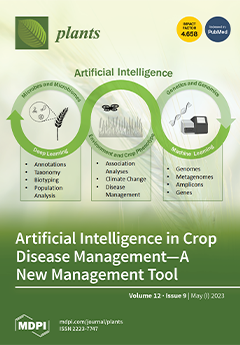Photosynthetic performance and biomass at different growth stages of the salt-sensitive KDML105 rice cultivar, three improved lines (RD73, CSSL8-94, and TSKC1-144), and the salt-tolerant standard genotype (Pokkali) were investigated under non-saline, semi-saline, and the heavy-saline field conditions in the northeast of Thailand. In the non-saline field, net photosynthesis rates (P
n) of all genotypes remained high from the early vegetative stage to the milky stage and then dramatically reduced at maturity. In contrast, in both saline fields, P
n was the highest at the early vegetative stage and continuously declining until maturity. Leaf chlorophyll content remained high from the early vegetative to milky stage then reduced at maturity for all three field conditions. During the reproductive phase, P
n of KDML105 and the improved lines were reduced by 4–17% in the heavy-saline field, while that of Pokkali was increased (11–19% increase over that of the non-saline). Pokkali also showed a prominent increase in water use efficiency (WUE) under salinity. Nevertheless, rice leaves under saline conditions maintained the PSII integrity, as indicated by the pre-dawn values of maximum quantum yield of PSII photochemistry (F
v/F
m) of higher than 0.8. Pokkali under the semi-saline and the heavy-saline conditions exhibited 51% and 27% increases in final biomass, and 64% and 42% increases in filled grain weight plant
−1, respectively. In the semi-saline condition, RD73, TSKC1-144, CSSL8-94, and KDML105 showed moderate salt tolerance by displaying 24%, 18.6%, 15%, and 11.3% increases in final biomass, and 24%, 4%, 13%, and 6% increases in filled grain weight plant
−1, respectively. In contrast, in the heavy-saline field, final biomass of RD73, KDML105, CSSL8-94, and TSKC1-144 showed 48%, 45%, 38%, and 36% reductions from that in the non-saline field, while the filled grain weight plant
−1 were reduced by 45%, 58%, 35%, and 32%, respectively. This indicated that the improved lines carrying drought- and/or salt-tolerance genes achieved an increased salt tolerance level than the parental elite cultivar, KDML105.
Full article






